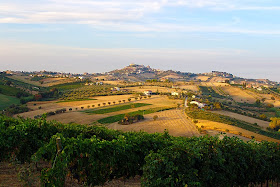 |
| Colline Teramane |
For years now, I have taken this advice, foisted upon me at an early age by a teacher and mentor who told me I had to step outside of the world I thought I knew. At first it was intimidating and scary. Going to a place where you don’t understand the language and the culture, it challenges all the preconceptions one has about the world on the inner screen of the mind. The realm one thinks is real.
How I wish every wine director I meet would take this advice. How much easier my job would be. Let’s drill down a bit.
 |
| Barbaresco - Casalinga - 1984 |
How many times do I go into an establishment to talk to someone about wine only to have him or her think they know more about the subject than they really do? Recently I had a wine buyer tell me that Barbera was the valley between Barolo and Barbaresco.
 |
| Matelica |
America, by virtue of the geographic isolation has caused many of us to be ignorant of the greater world. But in these times, when travel is easier (and less expensive) than it has ever been, I don’t see why young sommeliers wouldn’t allocate some of their budget for travel. The rewards are so instantaneous. The ah-hah! moments one has, around almost every corner, when they step away from their safe little world, these are priceless.
Stories, too many to tell over the last 20+ years. I remember one several months back, where this young guy wanted to show me his list. He was so proud of the treasures he had assembled. The list was impressive. I asked him for the food menu. He gave me a sideways look.
 |
| Trattoria Antica Torre, Barbaresco |
Clearly he and the chef were on different pages. The wine list was filed with gutsy, deep-throat wines, full of power and force. The food menu, a seasonal one, had just changed over to his summer menu. Vegetables, seafood, salads, all number of delicate treats were being offered. How does one pair fried zucchini blossoms with a soft oozy cheese and anchovies with a Sagrantino? One would know this from having traveled. One would know that the marriage of Italian food and wine is not a rough and tumble sex romp, wham-bam, over in three minutes or less, like some dramatized love scene in the movies. It’s a slow dance, it’s sensual. It is so much more meaningful than the mere cliché of penetration.
This same summer, on the last trip I made to Etna, I finally made it to see the winemaker Salvo Foti. He was having lunch outside with family and friends. It was a vegetarian repast, no meat. Surely this was no place for a tannic, powerful red. We drank rosé from Alicante, white from Carricante and then we only ventured into the (slightly) fuller red from Nerello when the cheeses arrived to the table. I want to tell the wine-list makers, “You need to go there. This is the kind of stuff your diners are dying to experience.” Who is listening?
 |
| Antica Salumeria Campanaro in Camigliatello Silano |
Often, in these days, in the evening and during the weekend, I haul myself over to a favorite Italian wine store in my neck of the woods. I stand there like a fool asking people if I can help them. My standard line is “What kind of wines are you used to? What do you like?” and 80% of the time they answer, "A big red wine, Cabernet. Merlot. Pinot Noir.” And then I proceed to ask them “What are you going to eat?” Then we can get down to it. From there it is easy to put a Montepulciano (from Abruzzo) or a Valpolicella, an Inferno or and Etna Rosso into their basket. If they have traveled (and many of them have) then we can relate to where they have been, what they did, what they ate, how it made them feel. That is what you, young sommelier, would be well advised to never forget. Yes, you need to master your tasting grid. Yes, you need to know the difference between Nebbiolo and Sangiovese. But you also must understand Italian wine in the greater context of the food, the land and the culture. And that means you have got to take the leap and travel. And travel. And travel some more. For the next 40 years or more.
And the same goes for the chefs. You think you “know” Italian food? Get thee to Italy, and often.
written and photographed by Alfonso Cevola limited rights reserved On the Wine Trail in Italy
wine blog + Italian wine blog + Italy W

